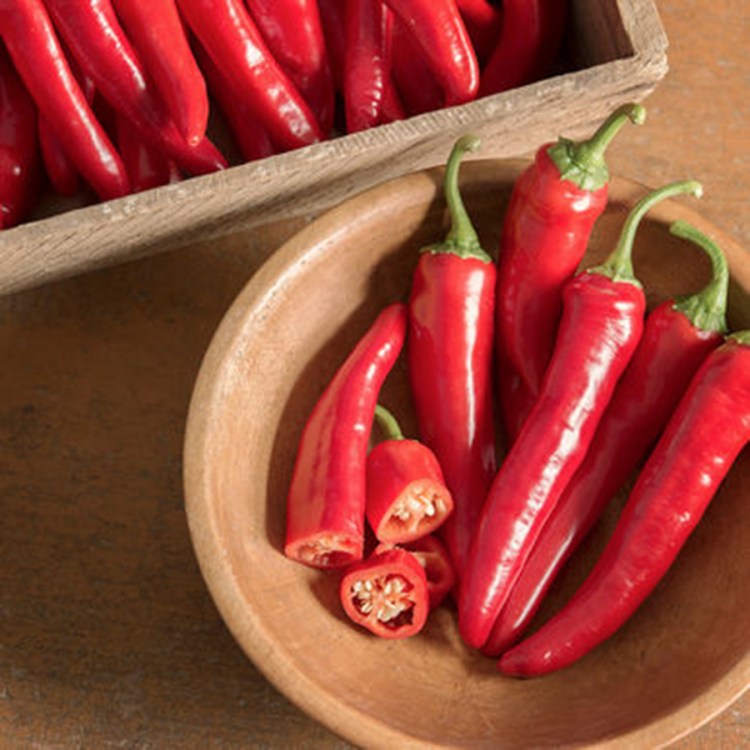Gardeners who want to spice up and/or increase the health benefits of the crops from their vegetable gardens this summer have two good choices from Johnny’s Selected Seeds, based in Winslow.
The cayenne pepper Red Ember and grape tomato Valentine were both named national All-America Selections (AAS) for 2018, bringing to 12 the number of AAS honors Johnny’s plants have received over the years. All-America Selections is a nonprofit that tests new seeds around the United States and Canada for their performance in the garden; winners have a kind of stamp of approval.
“It’s nice,” Johnny’s Chairman Rob Johnston said in what I consider an understatement. He then added more.
“Normally, when we start a breeding project it is sort of like getting married and planning a family,” he said. “When someone says ‘What do you think is going to come of this project?’ you say ‘Ask me again in 15 years, and I’ll give you some more information.’ ”
That time is up, and the results are positive.
AAS praised Red Ember for its early maturity, and its production of a large number of thick-walled fruits that are both flavorful and sweet and can be used fresh or dried.
Valentine won praise for its appetizing deep red color, sweet taste, resistance to cracking, early ripening and prolific production, and firm flesh – like a smaller Roma tomato.
Johnston described the process of breeding plants as a way to accelerate the random evolution of nature, creating better vegetables for Johnny’s customers, who are a mix of small market gardeners and avid home growers.

Valentine grape tomatoes from Johnny’s Selected Seeds of Winslow.
“We want them to be really easy to grow, because these people are growing everything and can’t become experts in any one plant,” Johnston said. “And we want them to taste good.”
This year’s winners accomplished those goals.
Janika Eckert started the work on Red Ember. She is now retired but was named AAS breeder of the year last year. Red Ember was created by crossing a really hot pepper with a really sweet one, Johnston said. With such crosses, the heat is dominant, but the fruit retains enough sweetness to make it really tasty, he said.
Valentine – which Johnny’s workers called the Wild Thing when it was under development – resulted from crossing some tomatoes in Johnny’s product line with the best wild tomato that scientists were producing at Pennsylvania State University.
Wild tomato heritage delivers “a really deep red color, which is an indication of high lycopene level, which is really good for you,” he said. The wild tomato flavor is a bonus, he added.
The two AAS winners are not the only new offerings from Johnny’s this year. Johnny’s entered two other vegetables in this year’s AAS competition. Johnston thinks they are better than the two award winners, yet they didn’t win anything.
In broadcast news what I’m about to write would be called a teaser – I’ll discuss those products next week in my column about what’s new in the catalogs.
All-America Selections named a total of 14 winners this year, including the two from Johnny’s. Find the complete list on their website, all-americaselections.org. One that interests me is Canna Pacific Orange, because my wife Nancy and I like the bright color of the tropical cannas on our patio in the summer. Pacific Orange is more compact than most and has more basal branching and long-lasting flowers.
The Perennial Plant Association’s Perennial of the Year took me by surprise.
Part of what I like about gardening is that there is so much to learn. I’ve been gardening for 42 years and writing about gardening going on 14 years, so I thought I knew what alliums are.
They’re onions, right?
Mostly you eat them. There are your standard bulb onions – which come in white, yellow and red and long-day and short-day varieties. Then there are specialty onions, such as shallots, leeks, scallions and chives. I like and have grown them all.
Ornamental gardeners, on the other hand, plant ornamental onions. These also are bulb plants that are planted in the fall, at the same time as tulips and daffodils, with dozens of options. We grow a lot of these, as well.
Allium “Millenium” the perennial plant of the year, shook up my perceptions.
It grows from fibrous roots rather than bulbs, producing a clump of 10- to 15-inch-tall grass-like foliage in the spring. In midsummer, two to three flower scapes rise above the foliage, and each scape produces two or three spherical rose-purple blossoms that last up to four weeks.
Even after that, the blossoms don’t disappear. They dry out to a tan color, sometimes holding on to a bit of the purple, and last through the season.
In addition to being an eye-catching spot of color during a time when many blossoms start to fade, they are a magnet for pollinators such as bees and butterflies.
This isn’t a new plant – it was introduced in 2000 by Plant Delights Nursery in North Carolina and was bred by Mark McDonough in Massachusetts. At the time, it earned the ire of editors everywhere because the plant name spelled millennium incorrectly, using just one “n.”
Allium “Millenium” prefers full sun and well-drained soil, and is hardy to all of Maine. It has few known disease problems and, as with most alliums, deer and other garden pests avoid it.
I might grow it in spite of the misspelling.
TOM ATWELL is a freelance writer gardening in Cape Elizabeth. He can be contacted at 767-2297 or at: tomatwell@me.com.
Send questions/comments to the editors.



Comments are no longer available on this story